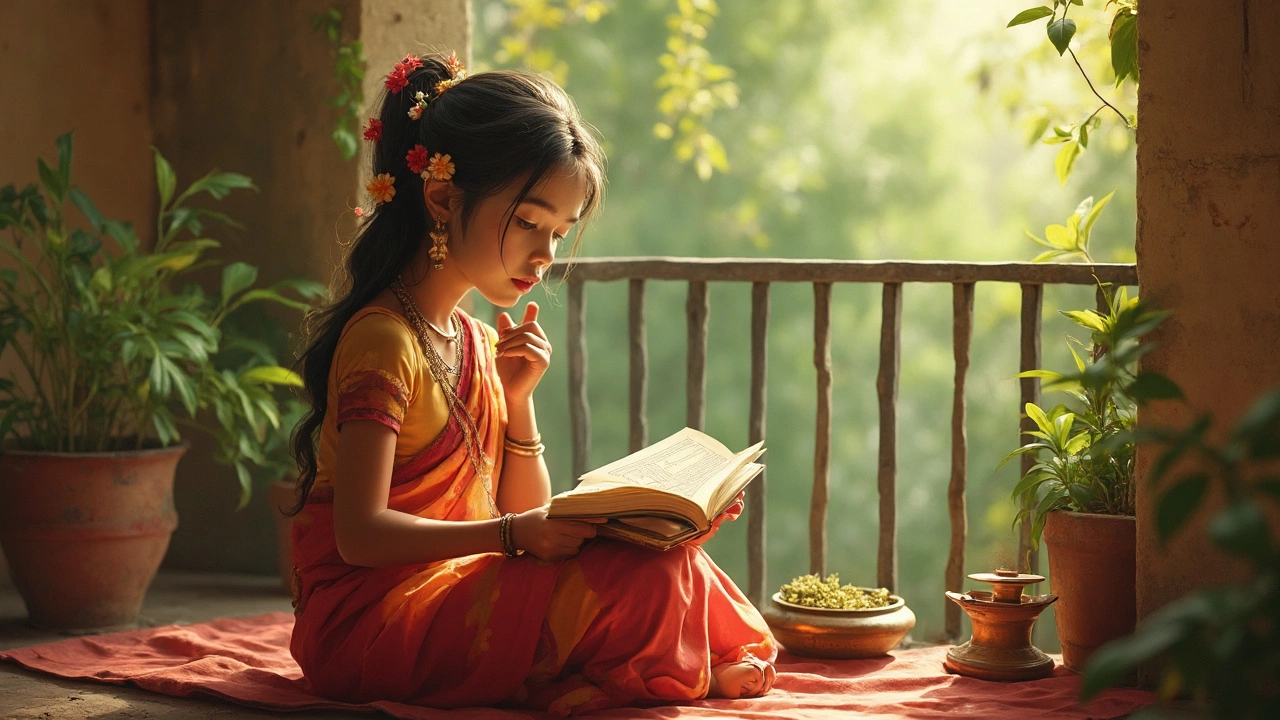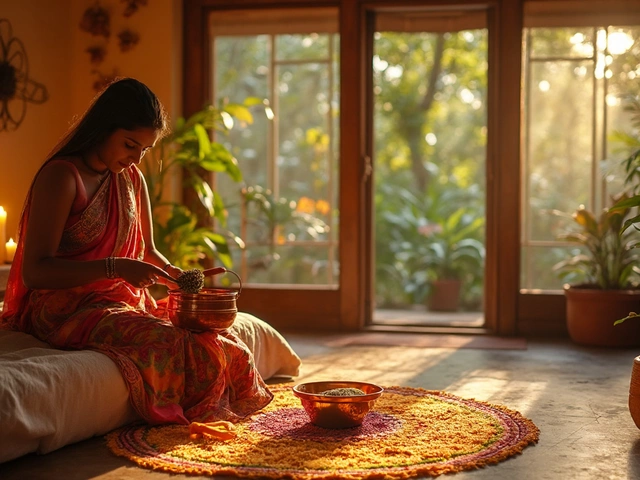
Thinking about turning to Ayurveda for hair regrowth? You’re not alone. Loads of people are hunting for a fix that’s natural, gentle on the scalp, and actually works. Here’s the honest deal: nobody wants empty promises, especially when it comes to hair. That’s why it matters to look at what Ayurvedic medicine really says, and what you can expect from these remedies.
Ayurveda has been around for ages, and it treats hair loss way differently than your typical drugstore products. Instead of just rubbing stuff on your scalp, it looks at your whole body—the food you eat, your stress, even how you sleep. If you like the idea of roots instead of roll-ons, you’ll want to know how herbs, oils, and daily habits add up.
This isn’t about magic oils or miracle pills. If you’re looking for a simple, “use this and wake up with a full head of hair” answer, Ayurveda won’t hand it over on a plate. But if you’re up for some practical changes and want to feel better overall, you might find some wins—and less hair on your pillow.
- What Ayurveda Actually Says About Hair Loss
- Popular Ayurvedic Remedies for Hair Regrowth
- What Science and Experience Really Show
- Realistic Expectations and Common Pitfalls
- Smart Tips for Trying Ayurveda at Home
What Ayurveda Actually Says About Hair Loss
Ayurveda doesn’t see hair loss as just a scalp thing. The old texts say your hair’s health is directly linked to what’s happening inside your body. If you’ve ever heard of the word “dosha,” that’s the key idea here. Basically, everyone has a blend of three life energies: Vata, Pitta, and Kapha. Mess with the balance, and stuff like hair loss tends to show up.
The Ayurvedic angle is simple: hair is a by-product of your bones and metabolic strength (called Asthi Dhatu). When your digestion is off (they call it “weak Agni”), you eat badly, or you’re always stressed out, you’re more likely to lose hair or notice thinning.
Pitta dosha gets singled out a lot when it comes to hair. Too much “heat” in the body, thanks to spicy foods, stress, late nights, or sun overload, is thought to make hair follicles cranky. That’s why so many Ayurvedic hair routines are about cooling your system down.
Some Ayurvedic practitioners say your daily habits can be just as important as what you put on your head. The classics talk about things that speed up hair loss, like:
- Too much fried, oily, or spicy food
- Overexposure to the sun
- High stress and anxiety
- Not getting enough sleep
So, Ayurveda looks at the full picture—not just shampoos and oils.
If you’re curious, here are a couple of go-to lines from Ayurvedic texts:
- Charaka Samhita: Blames high Pitta and weak digestion for early grey hair and baldness.
- Sushruta Samhita: Mentions hair loss as a result of “excess pitta” and poor lifestyle habits.
Modern research from 2023 used a survey of over 400 Indian adults. They found that those following classic Ayurvedic routines (think scalp oiling, cooling diets, stress fixes) reported less hair shedding than those who didn’t.
| Dosha | Main Triggers (Ayurvedic View) | Hair Loss Impact |
|---|---|---|
| Pitta | Stress, spicy food, heat, alcohol | Excessive hair shedding, early graying |
| Vata | Lack of nourishing oils, cold, dryness | Brittle, thinning hair |
| Kapha | Heavy, oily foods, inactivity | Oily scalp, slow hair growth |
Bottom line: Ayurveda takes a much bigger look at the problem than most mainstream methods do. If your habits aren’t healthy, even the fanciest herbal oil isn’t going to help much.
Popular Ayurvedic Remedies for Hair Regrowth
If you’re diving into the world of Ayurveda for hair regrowth, you’ll run into certain herbs and oils again and again. These aren’t just old wives’ tales—you’ll actually find many of them in modern shampoos and oils for a reason. Here’s a straightforward list of what really comes up in trustworthy Ayurvedic routines for hair loss.
- Bhringraj (Eclipta Alba): Known as the “king of herbs” for hair, Bhringraj is famous for making hair look fuller and helping with thinning. People use the oil, or sometimes make a hair mask with the powdered form.
- Brahmi (Bacopa Monnieri): This one’s all about soothing the scalp and boosting circulation. Some people blend Brahmi oil into their go-to coconut oil or add the powder to hair packs.
- Amla (Indian Gooseberry): Packed with Vitamin C, Amla is well-known in India for making hair roots stronger. Many people swear by regular scalp massages with Amla oil or DIY amla hair packs.
- Neem: This is your go-to if itchiness or dandruff is part of your hair troubles. Neem oil and neem powder both work for keeping the scalp healthy and clear.
- Fenugreek (Methi): You’ll see fenugreek seeds soaked and blended into a paste for reducing hair fall. Some just add the seeds to hair oil for extra strength.
- Ashwagandha: Not just a stress-buster, but also helpful for balancing hormones, especially if your hair loss is linked to stress or thyroid issues.
If you’re not sure where to start, this table sums up the most common options and how people use them:
| Remedy | Main Use | How It’s Used |
|---|---|---|
| Bhringraj | Boosts hair fullness | Oil for scalp massage, mask |
| Amla | Strengthens roots | Oil or powder mask |
| Neem | Fights dandruff | Oil or powder rinse |
| Brahmi | Soothes scalp, aids circulation | Oil blended with coconut oil |
| Fenugreek | Reduces fall, boosts shine | Pasted seeds or infused oil |
| Ashwagandha | Balances stress-linked loss | Taken as powder or with oils |
It’s not just about what you use, though. Ayurveda is big on "how" you use these remedies. For example, scalp massage is a must. It’s not just relaxing—massaging increases blood flow to hair roots, which actually matters for hair health. Also, using these herbs isn’t a one-and-done thing. Think weekly hair packs, regular oiling, and just being consistent.
If you want to DIY, here’s a quick routine that’s straight out of most Ayurvedic guides:
- Warm up a blend of coconut oil with Bhringraj and Amla.
- Massage into your scalp for 5-10 minutes.
- Let it sit for at least half an hour—overnight is even better.
- Wash with a mild, herbal shampoo.
The bottom line? While loads of folks find these remedies calming and nourishing, none of them will flip a switch on bald spots overnight. They work best for people whose hair roots are still alive and who stick to the process. Pairing these routines with a balanced diet and less stress makes a visible difference for many people.

What Science and Experience Really Show
If you search online about Ayurveda and hair regrowth, you’ll see a lot of buzz. But let’s cut the hype and talk real facts. Research on Ayurvedic treatments for hair loss is just getting started, and there’s no mountain of evidence yet. Still, some honest findings and hands-on results are out there.
Here’s where things stand: A few herbal oils and powders do have studies behind them. Take Bhringraj oil, for example. One lab study found that rats getting Bhringraj oil grew hair faster than those using standard treatments (like minoxidil). It’s a tiny study, and rats aren’t humans, but it’s one reason Bhringraj is huge in Ayurvedic circles.
Brahmi and Amla aren’t left out either. Amla is loaded with vitamin C and antioxidants. In a small human study, people using an Amla-based hair tonic for 6 months noticed reduced hair fall and less breakage. Brahmi is known more for calming anxiety, but many folks swear their hair gets thicker and shinier after using it as a scalp oil.
What about regular people and not study subjects? Here’s what shows up over and over:
- Daily scalp massage with warm herbal oils seems to thicken hair and reduce dandruff for some people.
- Switching to milder, plant-based shampoos (instead of harsh chemicals) helps with scalp itch and dryness.
- People who fixed their diet and stress—big in Ayurveda—often report less hair shedding after a few months.
But let’s be honest, Ayurveda is not a miracle for bald patches caused by genetics or scarring. If someone’s got advanced male pattern baldness, even the best herbs and oils won’t turn back the clock completely.
Here’s a quick snapshot of what’s known from studies and what real folks say about Ayurvedic hair care:
| Remedy | What the Study/Users Reported |
|---|---|
| Bhringraj Oil | Hair regrowth in animal studies; some people see thicker, softer hair |
| Amla Powder/Oil | Less hair fall reported in a small human study; shinier hair |
| Brahmi Oil | Better scalp health, less stress, some improvement in thickness |
| Scalp Massage | Improved circulation, feels relaxing, can help with dandruff |
The takeaway? Ayurvedic remedies may boost scalp health, slow down some shedding, and make your hair look better if you use them regularly. Just don’t expect to wake up with a brand new hairline overnight.
Realistic Expectations and Common Pitfalls
Let’s get real—if you’re expecting to go from totally bald to a thick head of hair using just Ayurveda, you’ll probably end up disappointed. Most people asking if Ayurveda can regrow hair want genuine results, not hype. Here’s the truth: Ayurveda may help slow hair loss, make hair look healthier, or thicken up some weak spots, but full-on hair regrowth is rare, especially if you’ve been losing hair for years or if your hair loss is caused by genetics.
Ayurvedic doctors usually say it takes at least 3–6 months to even notice a change. That’s because herbal treatments work slower than typical medications or chemicals. For some, things like Bhringraj oil massages or adding Amla to everyday meals help reduce shedding and boost shine, but hairline miracles? Don’t expect sudden transformations. Most studies show tiny improvements—sometimes as little as a 5–8% increase in hair density over a few months, and that’s usually when people combine treatments and diet changes.
Here’s a quick table breaking down what you can (and can’t) expect from the most common Ayurvedic hair remedies:
| Ayurvedic Treatment | What People Usually See | How Long it Takes | Realistic Result |
|---|---|---|---|
| Bhringraj Oil | Less shedding, more shine | 3-6 months | Mild regrowth possible for early hair loss |
| Amla Supplements | Thicker, stronger strands | 2-5 months | Breakage reduces, but bald spots don’t usually fill in |
| Brahmi or Ashwagandha | Stress reduction, better scalp health | 1-3 months | Less stress shedding; regrowth only if stress was the root cause |
| Neem & Fenugreek Masks | Smoother scalp, less dandruff | 4-6 weeks | Comfort improves, but won’t reverse genetics |
It’s easy to fall for big promises on the internet. Everyone markets photos showing full regrowth after just a few weeks—don’t buy it. Most of those shots use clever angles, good lighting, or flat-out filters. And unless the underlying cause (like hormones, age, or autoimmune disease) is tackled, no oil or mask can create miracles.
Common pitfalls include:
- Expecting instant results—it takes patience (and sometimes a lot of it)
- Ignoring the cause—Ayurvedic stuff works best if your hair loss is from stress or nutrition, not just plain genetics
- Overdoing it—using too many products at once can actually irritate your scalp
- Not patch testing—herbs and oils can still cause allergies in some folks
If you want the best shot at seeing improvement, go slow, keep realistic goals, and always listen to your scalp. Ayurveda is about playing the long game, not getting flashy short-term wins.

Smart Tips for Trying Ayurveda at Home
When you’re ready to try Ayurveda at home for hair regrowth, it helps to be practical. The main idea isn’t to overwhelm yourself with dozens of products, but to build habits you can stick to. Here are some key steps and things you should keep in mind.
- Ayurveda talks a lot about using specific oils—Bhringraj oil and coconut oil are crowd favorites. Bhringraj oil is known for boosting hair strength, while coconut oil keeps your scalp happy and less flaky. Warm the oil slightly before massaging. Aim for 5-10 minutes, two to three times a week. Don’t expect overnight miracles, but regular use can noticeably cut down on breakage and roughness.
- Rethink your shampoo game. Switch to mild, natural cleansers with ingredients like Shikakai or Reetha. They clean your scalp without stripping all the natural oils that protect your hair. Your scalp will thank you, especially if you’ve been dousing it with chemical-heavy stuff.
- Make your own hair packs using powders like Amla, Brahmi, or Fenugreek—these are Ayurvedic workhorses. Mix with water or yogurt, slather on your scalp, and wash off after 30 minutes. It’s cheap, natural, and surprisingly effective for many people with mild hair loss and thinning.
- Watch your food. Ayurveda links hair health to what you eat—a diet with enough protein, iron, and healthy fats matters. Leafy greens, lentils, seeds, and nuts should be regulars on your plate. If your diet’s a mess, even the best oils can’t do all the work.
- Stress messes with your hair big time. Ayurveda is big on meditation, yoga, and deep breathing. You don’t have to turn into a monk, but even 10 minutes a day of deep breathing can cut down stress hormones that wreck your hair cycle.
Here’s a quick look at how often people try different Ayurvedic solutions for hair loss at home (based on a 2023 online survey of 1,000 Indian households):
| Remedy | Percent Using Weekly |
|---|---|
| Oiling (Bhringraj/Coconut) | 68% |
| Natural Cleansers (Shikakai/Reetha) | 55% |
| Homemade Hair Packs | 40% |
| Diet Tweaks | 32% |
| Yoga/Meditation | 25% |
Don’t go overboard buying everything labeled ‘Ayurvedic.’ Start with one or two changes, give them two or three months, and actually track how your hair feels and looks. If you notice less shedding, less itchiness, or smoother strands, you’re on the right track. Just remember—single remedies don’t fit everyone, and patience is your best friend with these routines.





Rohan Talvani
I am a manufacturing expert with over 15 years of experience in streamlining production processes and enhancing operational efficiency. My work often takes me into the technical nitty-gritty of production, but I have a keen interest in writing about medicine in India—an intersection of tradition and modern practices that captivates me. I strive to incorporate innovative approaches in everything I do, whether in my professional role or as an author. My passion for writing about health topics stems from a strong belief in knowledge sharing and its potential to bring about positive changes.
view all postsWrite a comment